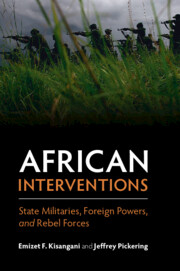Book contents
- African Interventions
- African Interventions
- Copyright page
- Dedication
- Contents
- Figures
- Tables
- Acknowledgments
- Abbreviations
- 1 Context and Issues of International Military Intervention
- 2 Non-colonial Military Interventions in Africa
- 3 Military Intervention by Former Colonial Powers in Africa
- 4 Intra-African Hostile Military Intervention
- 5 Intra-African Supportive Military Intervention
- 6 African Intervention into Failed States
- Conclusion
- Appendices
- Notes
- References
- Index
4 - Intra-African Hostile Military Intervention
Published online by Cambridge University Press: 29 October 2021
- African Interventions
- African Interventions
- Copyright page
- Dedication
- Contents
- Figures
- Tables
- Acknowledgments
- Abbreviations
- 1 Context and Issues of International Military Intervention
- 2 Non-colonial Military Interventions in Africa
- 3 Military Intervention by Former Colonial Powers in Africa
- 4 Intra-African Hostile Military Intervention
- 5 Intra-African Supportive Military Intervention
- 6 African Intervention into Failed States
- Conclusion
- Appendices
- Notes
- References
- Index
Summary
Hostile military interventions have been common in postcolonial Africa. Chapter 4 begins with East Africa, the locale of the largest number of hostile military interventions. Central Africa, Southern Africa, North Africa, and West Africa follow. Many of these hostile interventions have targeted transnational rebels operating from neighboring states that pose a challenge to the incumbent regime. Ideological rivalry played a role in state sponsorship of rebel groups and interstate tensions during the Cold War, and local interstate rivalries have been present in the post-Cold War period. Although some regional differences emerged in the historical narrative, results from qualitative comparative analysis suggest that states with prominent foreign policy roles on the continent target rebels in neighboring states, but when rivalries or subsystemic crises are present states without prominent role status intervene as well. Domestic conditions may also pose a challenge to a government’s tenure and compel it to use hostile force, often against targets that represent a tangible threat to the ruling ethnic group. Negative economic growth and inflation are the domestic pressures that most frequently help to explain hostile military intervention in postcolonial Africa, demonstrating that when combined with other conditions the diversionary argument has purchase in this context.
Keywords
- Type
- Chapter
- Information
- African InterventionsState Militaries, Foreign Powers, and Rebel Forces, pp. 144 - 202Publisher: Cambridge University PressPrint publication year: 2021



